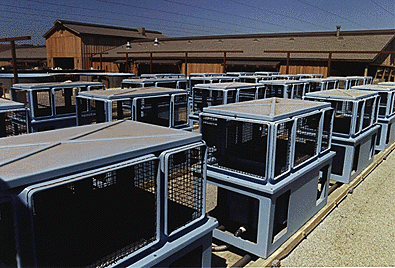![[Currents header graphic]](/homeart/currents_header.gif)
![[Currents header graphic]](/homeart/currents_header.gif)
July 21, 1997
Nation's first oiled wildlife center opens next to Long Marine Lab

|
|
The new center will help California's wildlife and habitat survive oil spills.
|
By Robert Irion
California's citizens, be they environmentalists or petroleum industrialists, are united in their hopes that the state will never suffer a catastrophic oil spill along its coastline. But if the unthinkable occurs, rescue workers are now much better prepared to deal with the resulting onslaught of tarred sea otters, seabirds, and other wildlife.
That preparedness stems from the state's new Oiled Wildlife Veterinary Care and Research Center, which state and local officials will dedicate today (July 21) in a ceremony on UCSC property next to the Joseph M. Long Marine Laboratory. The $5 million facility, the first of its kind in the nation, opens after four years of planning and more than a year of construction at the oceanfront site.
Researchers from the California Department of Fish and Game's Office of Oil Spill Prevention and Response (OSPR) and UCSC's Institute of Marine Sciences will operate the center jointly as a full-time research facility. Veterinarians, toxicologists, and other scientists will collaborate on studies related to the impact of petroleum products on California's wildlife and habitat, as well as baseline studies of the health of marine mammals and seabirds.
In the event of an oil spill, the center can accommodate 125 sea otters, 100 marine birds, and a few seals and sea lions, cleaned and cared for by up to 100 veterinary staff, researchers, and volunteers. The center also will host periodic training and response exercises for OSPR teams.
Speakers at the dedication ceremony will include OSPR Administrator Pete Bontadelli, Chancellor Greenwood, and California Department of General Services Deputy Director Eugene A. Spindler II. Guests will include U.S. Representative Sam Farr, who as a California assemblyman spearheaded the center's creation and the selection of Long Marine Lab as its site.
"We never know when an oil spill is going to happen or how widespread the damage will be," Farr said. "The rescue center will ensure that animals will be treated quickly and professionally."
The state legislature mandated the center in 1991 in response to concerns that a large spill could endanger or wipe out numerous species, especially the threatened California sea otter. Funding came from a tax imposed upon oil companies and from lease sales of offshore drilling sites in southern California.
The chaotic nature of the animal rescue effort in Alaska following the Exxon Valdez oil spill in 1989 convinced many researchers that a permanent facility would improve the chances of saving wildlife. The new center focuses on sea otters, whose thick fur and nearshore living patterns make them particularly vulnerable to oil's damaging effects.
Six full-time and two part-time veterinary, research, and administrative staff members from the Department of Fish and Game will work at the center. UCSC researchers will have continual access to two outdoor marine-mammal pools and some of the indoor lab space. During non-emergency times, two other outdoor pools and additional lab space also will be reserved for UCSC and Long Marine Lab use.
Specific areas of collaboration planned by UCSC groups include: